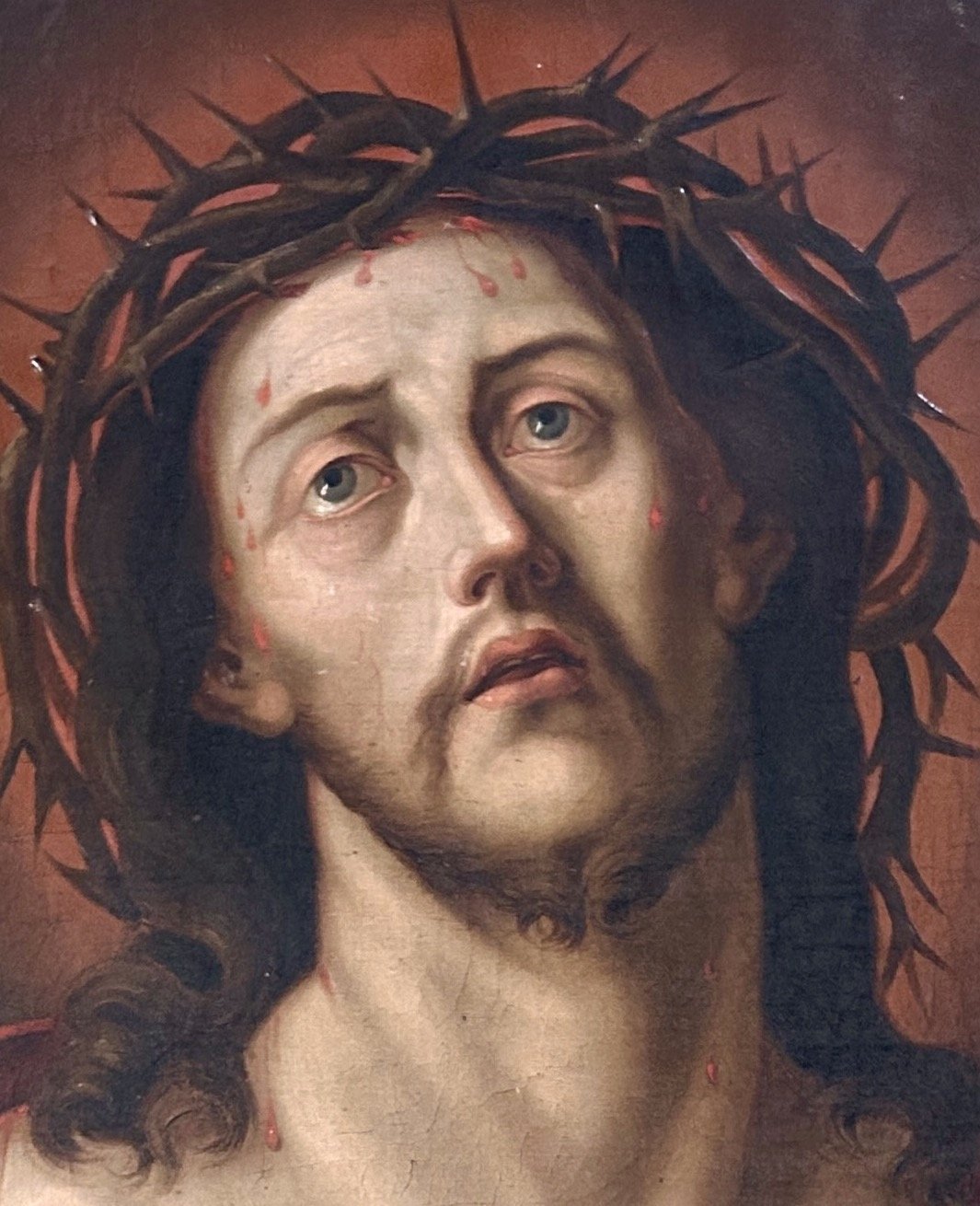 Image 1 of 12
Image 1 of 12

 Image 2 of 12
Image 2 of 12

 Image 3 of 12
Image 3 of 12

 Image 4 of 12
Image 4 of 12

 Image 5 of 12
Image 5 of 12

 Image 6 of 12
Image 6 of 12

 Image 7 of 12
Image 7 of 12

 Image 8 of 12
Image 8 of 12

 Image 9 of 12
Image 9 of 12

 Image 10 of 12
Image 10 of 12

 Image 11 of 12
Image 11 of 12

 Image 12 of 12
Image 12 of 12













19th Century Ecce Homo Oil Painting of Christ in Crown of Thorns by Johann Baptist Reisbacher the Elder
Early 19th Century German oil on canvas Ecce Homo religious portrait of Christ wearing a Crown of Thorns by Johann Baptist Reisbacher the Elder (1803 - 1850).
Inscribed on the reverse and dated 1835.
In period ebony and gold frame.
Signs of age to the paint surface. Strong detail and colour.
Johann Baptist Reisbacher the Elder was a Bavarian church painter, and in 1832 he founded the Kollnburg painting tradition, an offshoot of the Neukirchen School.
Image H: 57.5 x W: 40.5 cm / Frame H: 69 x 53 cm.
Ecce homo "behold the man" are the Latin words used by Pontius Pilate when he presents a scourged Jesus, bound and crowned with thorns, to a hostile crowd shortly before his crucifixion. The scene has been widely depicted in Christian art.
A scene of the ecce homo is a standard component of cycles illustrating the Passion and life of Christ in art. It follows the stories of the Flagellation of Christ, the crowning with thorns and the mocking of Jesus, the last two often being combined.
From the 15th century in the West, and much earlier in the art of the Eastern church, devotional pictures began to portray Jesus alone, in half or full figure with a purple robe, loincloth, crown of thorns and torture wounds, especially on his head, and later became referred to as images of the Ecce homo. Similar subjects but with the wounds of the crucifixion visible (Nail wounds on the limbs, spear wounds on the sides), are termed a Man of Sorrows. If the instruments of the Passion are present, it may be called an Arma Christi.
The motif of the lone figure of a suffering Christ who seems to be staring directly at the observer, enabling him/her to personally identify with the events of the Passion, arose in the late Middle Ages.
Early 19th Century German oil on canvas Ecce Homo religious portrait of Christ wearing a Crown of Thorns by Johann Baptist Reisbacher the Elder (1803 - 1850).
Inscribed on the reverse and dated 1835.
In period ebony and gold frame.
Signs of age to the paint surface. Strong detail and colour.
Johann Baptist Reisbacher the Elder was a Bavarian church painter, and in 1832 he founded the Kollnburg painting tradition, an offshoot of the Neukirchen School.
Image H: 57.5 x W: 40.5 cm / Frame H: 69 x 53 cm.
Ecce homo "behold the man" are the Latin words used by Pontius Pilate when he presents a scourged Jesus, bound and crowned with thorns, to a hostile crowd shortly before his crucifixion. The scene has been widely depicted in Christian art.
A scene of the ecce homo is a standard component of cycles illustrating the Passion and life of Christ in art. It follows the stories of the Flagellation of Christ, the crowning with thorns and the mocking of Jesus, the last two often being combined.
From the 15th century in the West, and much earlier in the art of the Eastern church, devotional pictures began to portray Jesus alone, in half or full figure with a purple robe, loincloth, crown of thorns and torture wounds, especially on his head, and later became referred to as images of the Ecce homo. Similar subjects but with the wounds of the crucifixion visible (Nail wounds on the limbs, spear wounds on the sides), are termed a Man of Sorrows. If the instruments of the Passion are present, it may be called an Arma Christi.
The motif of the lone figure of a suffering Christ who seems to be staring directly at the observer, enabling him/her to personally identify with the events of the Passion, arose in the late Middle Ages.